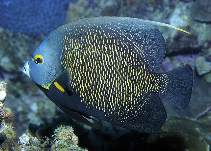| Family: |
Pomacanthidae (Angelfishes) |
| Max. size: |
41.1 cm TL (male/unsexed); max. reported age: 27 years |
| Environment: |
reef-associated; marine; depth range 3 - 100 m, non-migratory |
| Distribution: |
Western Atlantic: Florida, USA and Bahamas to Brazil, including the Gulf of Mexico and the Caribbean (Ref. 26938). Eastern Atlantic: off Ascension Island (Ref. 7379) and St. Paul's Rocks (Ref. 13121). |
| Diagnosis: |
Dorsal spines (total): 10-10; Dorsal soft rays (total): 29-31; Anal spines: 3-3; Anal soft rays: 22-24. Black, the scales of the body , except those at front from nape to abdomen, rimmed with golden yellow; a broad orange-yellow bar at pectoral absent; dorsal filament yellow; chin whitish; outer part of iris yellow; eye narrowly rimmed below with blue (Ref. 13442) |
| Biology: |
Common in shallow reefs. Usually in pairs, often near sea fans (Ref. 9710). Feed on sponges, algae, bryozoans, zoantharians, gorgonians and tunicates (Ref. 9626). Oviparous (Ref. 240), monogamous (Ref. 52884). Spawning pairs are strongly territorial, with usually both members vigorously defending their areas against neighboring pairs (Ref. 38726). Juveniles tend cleaning stations where they service a broad range of clients, including jacks, snappers, morays, grunts, surgeonfishes, and wrasses. At the station the cleaner displays a fluttering swimming and when cleaning it touches the clients with its pelvic fins (Ref. 40094). Flesh considered good quality; marketed fresh (Ref. 3797). Has been reared in captivity (Ref. 35419). |
| IUCN Red List Status: |
Least Concern (LC); Date assessed: 08 October 2009 Ref. (130435)
|
| Threat to humans: |
reports of ciguatera poisoning |
Source and more info: www.fishbase.org. For personal, classroom, and other internal use only. Not for publication.

